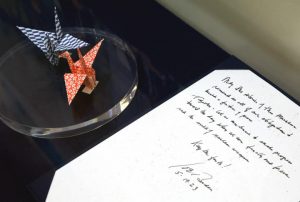Summer following conclusion of Hiroshima Summit—Did G7 leaders truly see Hiroshima? Part 6: Visit by another US president
Jul. 26, 2023
Folded paper cranes carry wishes for nuclear-free world
Some A-bomb survivors have mixed feelings about future orientation
by Kaori Ota, Staff Writer
Two folded paper cranes of red and blue patterned paper were on display in a glass case. On July 25, a retrospective exhibit in recognition of the summit meeting of the G7 (Group of Seven industrialized nations) was held at the International Conference Center Hiroshima in Peace Memorial Park, located in the city’s Naka Ward. The two paper cranes, folded at the White House and brought to the Peace Memorial Museum by U.S. President Joe Biden, were introduced as a legacy of the Hiroshima Summit.
Sadako’s wish
Seven years ago, Barack Obama, the first sitting U.S. president to visit Hiroshima, brought with him to the museum four folded paper cranes. It was reported at the time that Mr. Obama had commented to a close aide about the beauty of the cranes he had seen in the Hiroshima Peace Memorial Museum’s East Building that were folded by Sadako Sasaki, who died of leukemia 10 years after the atomic bombing. The U.S. government did not reveal any details about the recent paper cranes, but empathy from the two U.S. presidents for the story about the girl from Hiroshima and for the message of “a world without nuclear weapons” is evidenced by the paper cranes.
Sadako experienced the atomic bombing while at her family home in the area of Kusunoki-cho (now part of Nishi Ward), about 1.6 kilometers from the hypocenter, when she was two years old. Later, she attended Noboricho Elementary School (in present-day Naka Ward). Hideo Mito, 80, a resident of Naka Ward and a classmate, described Sadako. “She was an energetic girl and a really fast runner. She sometimes even beat me,” he said as he recalled the times they practiced together as relay runners for track tournaments.
Nonetheless, that cheerful girl developed leukemia when she was in the sixth grade. While hospitalized, Sadako continued folding paper cranes in hopes of recovering from her illness. Mr. Mito says, “When I visited her, Sadako smiled and said, ‘Each paper crane I fold will lengthen my life by a day.’” Asked for his feelings about the presidents of the country that dropped the atomic bomb bringing paper cranes, he was philosophical. “Everyone wants peace. The U.S. presidents probably also felt strongly about that,” said Mr. Mito.
Coinciding with the Hiroshima Summit, the United States consulted with the Hiroshima City government on a sister park arrangement between the Pearl Harbor National Memorial, which explains the Pearl Harbor attack by the Japanese military, and Peace Memorial Park. At the signing ceremony for the arrangement held at the U.S. Embassy (in Tokyo) on June 29, U.S. Ambassador to Japan Rahm Emanuel emphasized that “these parks, which were once sites of conflict, are now places of reconciliation.” The United States appears to desire the establishment of a relationship with the A-bombed city in a future-oriented manner.
“Undying hatred”
Some A-bomb survivors have mixed feelings about that idea. Minoru Hataguchi, 77, former director of the Hiroshima Peace Memorial Museum who is a resident of Hatsukaichi City, experienced the atomic bombing while in his mother’s womb. His father died in the bombing. In response to the ideas of reconciliation and friendship with the United States, he revealed his true feelings. “I would like to move in that direction, but my hatred will never fade away.”
On their visits to Hiroshima, the two U.S. presidents did not apologize for the atomic bombing, which indiscriminately killed innocent civilians. They are surmised to have brought with them into Peace Memorial Park what is called a ‘nuclear football,’ a specially designed briefcase with communications equipment for ordering a nuclear attack, revealing how the country’s stance remains fixated on nuclear weapons.
Mr. Hataguchi points out that a lifetime of fear and anxiety about invisible radiation and the pain of not being able to openly express those feelings are fixed in the reality of the atomic bombing, different from the destruction caused by conventional aerial attacks. Sadako’s paper cranes are a memento of a girl who suffered the same fear as well as evidence of the inhumanity of nuclear weapons.
Now that the Hiroshima Summit has concluded, the leaders need to be asked whether they truly saw Hiroshima.
Keywords
Visit to Hiroshima by U.S. President Barack Obama
On May 27, 2016, Barack Obama, the first sitting U.S. president to visit Hiroshima City, spent 52 minutes in Peace Memorial Park, located in the city’s Naka Ward. After observing the belongings of A-bomb victims specially exhibited on the first floor of the Hiroshima Peace Memorial Museum’s East Building, he offered a wreath of flowers at the Cenotaph for the A-Bomb Victims. He delivered a 17-minute address in front of the cenotaph, to which about 100 people (including 10 A-bomb survivors) had been invited. He declared at that time, “We must have the courage to pursue a world without nuclear weapons.” After his address, Mr. Obama walked up to and exchanged words with the late Sunao Tsuboi, who then served as co-chair of the Japan Confederation of A- and H-Bomb Sufferers Organizations (Nihon Hidankyo) and chair of the Hiroshima Prefectural Confederation of A-bomb Sufferers Organizations, as well as with Shigeaki Mori, who has conducted research into U.S. soldiers who experienced the atomic bombing in Hiroshima.
(Originally published on July 26, 2023)







